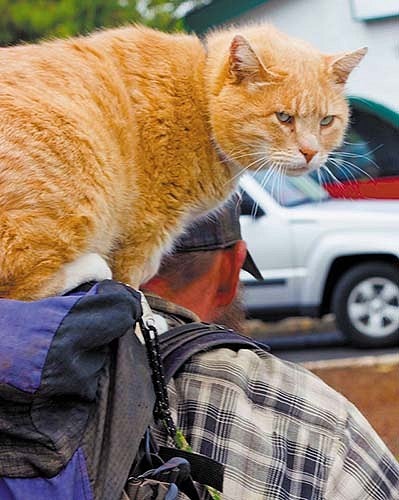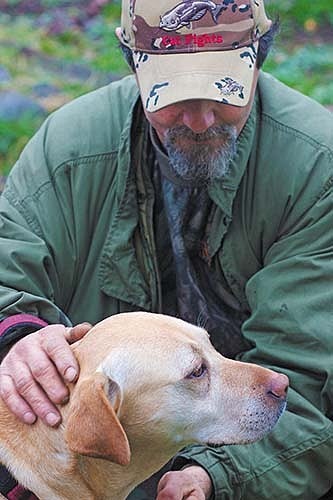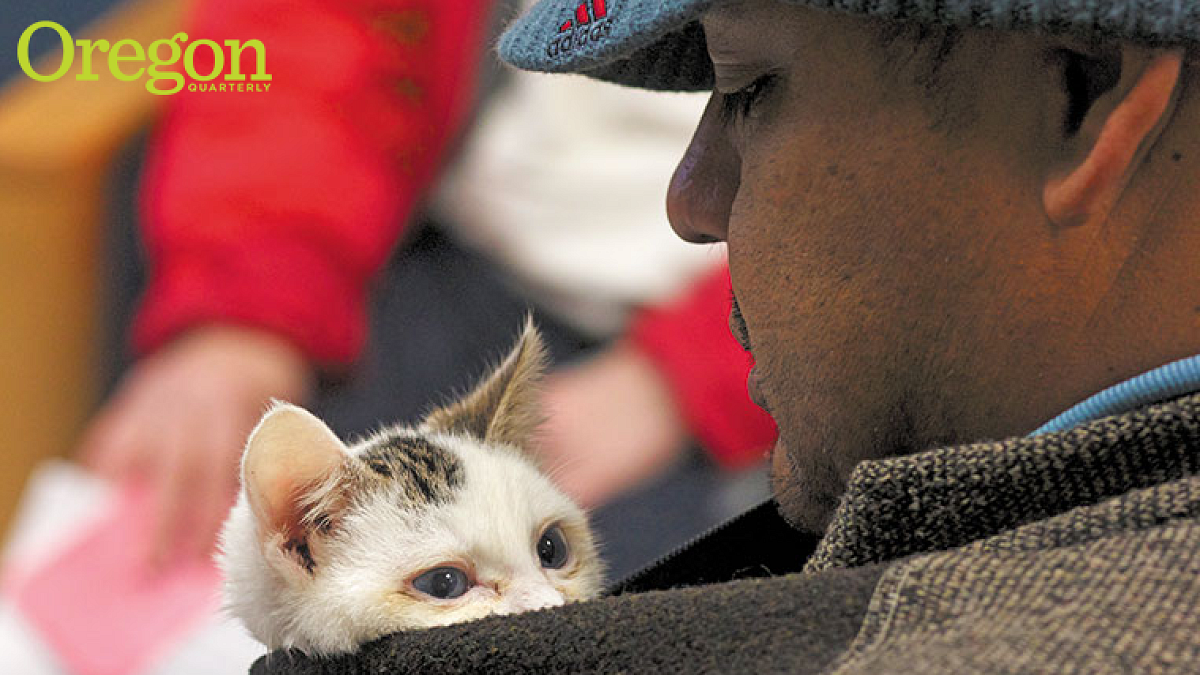He sat in the veterinary clinic, his beard long and wiry, his eyes red and glazed. His large orange cat, Moe, lay dying. “They said that they’d euthanize him.” Catman recalls, “I told them, ‘I don’t want to hear about that.’” He knew they only offered euthanasia over treatment due to his financial instability.
Catman and his blue-eyed cat are homeless.
The cat has had occasional bladder issues since he was neutered a few years ago. The night before they came to the clinic, he wasn’t acting like his normal playful self. “In the morning he was just lying there, not moving,” says Catman (his real name is Bradley), who carried Moe several miles to the clinic. When he attempted to place Moe on top of his backpack, where the cat normally rides, he fell off. “I had to carry him on my back by holding his paws.”
Across the nation, nonprofits are working to help animals like Moe. According to 2014 data from the Department of Housing and Urban Development, there are more than 12,000 homeless people in Oregon out of roughly 3.9 million people in the state. Across the nation, nearly 10 percent of homeless people own a dog, a cat, or both. In some areas, the number of pet owners is as high as 24 percent, according to the nonprofit organization Pets of the Homeless. All pets need proper veterinary care, which can be hard for families with steady incomes to afford, let alone an individual with no home.

What Catman didn’t know is that multiple local radio stations made announcements to raise donations to help cover Moe’s medical expenses. Tears welled up in his eyes when he found out. “I just can’t believe the support we are getting,” he said. He turned away, embarrassed, then looked toward his cat, who now sat in the grass yawning. “Moe has a lot of friends.”
Pro-Bone-O, a nonprofit dedicated to helping animals in need, is one of several organizations in Eugene that offers veterinary care for homeless people’s pets. Although the organization schedules surgeries for serious cases, they more often give out food, flea treatments, vaccinations, and worm medications.
“These animals are often their only family, something for them to live for and take care of,” says Jeanie Peterson, the nonprofit’s past president.
Peterson has been working with Pro-Bone-O since the clinic opened in 1998. She says the organization treats about 50 animals at every clinic, and adds that the animals she sees are some of the most well-trained and socialized pets she’s experienced. She believes that homeless people have every right to own pets and that the pets may help those with mental disabilities. “These pets could be a lifeline,” she says.
Pops is a veteran with severe post-traumatic stress disorder. Three years ago his wife passed away, and he and his dog, Bubba, became homeless.
Pops, a thin, older man with a scraggly beard who struggles with substance abuse, and Bubba, an energetic white pit bull, usually keep to the river, but stay in homeless camps occasionally. “He’s not my dog,” Pops says. “He’s my friend.”
Bubba eats whatever Pops eats, and in poor weather they either seek shelter or share a fire for warmth. “I am disabled, and life can be hard,” Pops says. “I’m glad I have Bubba; he’s my pal.”
Peterson says that most pet owners who can’t find shelter will share their sleeping bags, clothes, and blankets with their pets in order to keep them warm and covered. A few shelters welcome the homeless along with their pets, as does the Egan Warming Center, which opens during frosty winter nights.
Not everyone believes that services should be provided to animals if they are in the care of someone who is homeless. “I’ve heard, ‘The animals are just a tool used to engender sympathy and generosity when panhandling,’” says Peterson, adding that many people think the pets are subject to abuse or neglect. She believes that the negative emotions about homeless people having pets are due to a lack of knowledge.
Jen Madeira, a certified veterinary technician, agrees that some pets are used as props. At the Emergency Veterinary Clinic in Springfield, she has seen homeless people bring in their pets for severe dog bites, diseases, sickness, and allergies. Some are pregnant. The clinic must turn these pets away if the owners can’t afford their care, and people have become angry and yelled at employees for refusing to provide free services. “Minimal care isn’t enough,” Madeira insists. “If you can’t afford to give decent care then you probably shouldn’t own them (pets).”
Madeira believes that those who can’t afford medical care should not expect businesses to give free services. “I understand that the pets provide protection and companionship,” she said, “but it’s difficult when they bring hurt or sick animals into the clinic with nothing to give.”

Keith Gray, the client care coordinator for the Emergency Veterinary Clinic, agrees with Madeira. He said the homeless shouldn’t be allowed to own pets they can’t afford to care for. “It’s like having a kid. If you can’t take care of yourself, then you shouldn’t be responsible for something else.”
Unhoused animals are suseptible to more diseases and injuries than those with a safe living environment, he explains. Animals need decent pet foods, grooming, and medical care. The clinic euthanizes the pets at no charge if they are in critical condition. “If euthanizing is the humane thing to do, we will do that for free,” Gray says softly. “It’s not fair for the animal to suffer.”
At a homeless camp in Eugene, people laughed as Pops’s dog, Bubba, bounded around them. They referred to him as Mr. Wags. Some said they believed Bubba had gotten into someone’s drugs—their explanation for the dog’s hyper attitude. Bubba, they said, had been crashing into tents the night before.
Before Moe, Catman, who struggles with alcoholism, had a cat named Scruff. “I was traveling with some friends in an RV,” he explains. They had stopped in a Walmart parking lot, letting Scruff out. “I blacked out in the back and woke up some 200 miles later saying, ‘Where’s my cat?!’”
Moe was a birthday gift from the driver of the RV to replace Scruff. Catman and Moe have been together in the Eugene community for six years. A couple of years ago, Moe ate a chicken bone. The bone got stuck sideways inside him, causing him to vomit profusely and have severe diarrhea. Catman took Moe to a nearby veterinary clinic for medical assistance.
“I cried and begged them to help Moe,” he says. “He was dying; he needed help.” The clinic kept Moe overnight and treated him free of charge. That clinic has helped him provide Moe with all the medical attention he has needed, including neutering.
Greenhill Humane Society in Eugene gives out pet food to homeless people and low-income families. Executive director Cary Lieberman, MS ’93, says Greenhill often works with Pro-Bone-O to provide spay and neuter services.
Although some animals have to be confiscated due to poor living situations, Lieberman says the worst animal treatment he has witnessed has not been by homeless pet owners. “We get more pets into the shelter from housed families than homeless people.”
Lieberman received his designation as a certified animal welfare administrator in 2009. He thinks that everyone should be allowed to have a pet. “I don’t think human rights should be taken away for financial issues,” he says.
Cars roar past, kicking dust and exhaust into Catman’s face as he stands dangerously close to the street corner. Moe sits leashed several feet away with a bored expression. He stretches out across the cool grass. His blue eyes watch Catman, who holds his sign a little higher. It reads, “anything helps, god bless.”
A man approaches them, offering some loose change. “This is for your attack cat,” he says with a chuckle. After thanking him, Catman pours some medicinal cat food into Moe’s dish and strokes his orange back. Moe eats his food, looking healthy and happy. “Moe,” Catman says, “means everything to me.”
*** *** ***
A CARING PHILOSOPHY
Jon LaRochelle, a PhD student and graduate teaching fellow in the University of Oregon’s philosophy department, helped organize a public forum last fall that was designed to spread awareness of homelessness in Lane County. The department hopes to give people a better understanding of the magnitude of the issue, the resources that exist, and ways to help.
“One of the mistakes we make in talking about homelessness is trying to pick out the reason why there are so many people living without shelter,” LaRochelle says. “I think we do folks a disservice when we kind of settle on one particular explanation that will tell us why they are there.”

The philosophy department’s project includes three parts. One involved creating a website that lists local services, media, photography, and scholarly articles to act as a resource for both academics and the community. The website also offers the opportunity to read narratives from local homeless people. The second part of the project involved the public forum, which drew in people from UO and the community, to raise awareness. Finally, the department held a roundtable discussion on the issue; among the speakers were the mayors of Springfield and Eugene, city council members, members of the philosophy department, and service providers from Opportunity Village, a low-cost “tiny house” community for those in need of housing.
According to LaRochelle, philosophy professor Naomi Zack suggested the topic of homelessness for the event and participated in running it. LaRochelle helped organize and advertise it in a way that would alert needed members of the community, such as people in medical and service fields.
Faculty members and students in the philosophy department are hoping for a discussion on what the university’s role in helping the homeless might be, including possibilities such as bringing changes to the curriculum, developing focused research projects, and establishing institutional commitments to aiding the unhoused community. These efforts are still in the planning stage. “Students have a lot of energy,” LaRochelle says. “One of the benefits of getting something on their radar and having it be a consistent part of the curriculum is that you can create an institutional mechanism where people are continually being reminded that this is an issue, that this is something they should be paying attention to.”
—By Brandi M. Gardner
Brandi M. Gardner, BA ’14, studied journalism at the UO.


